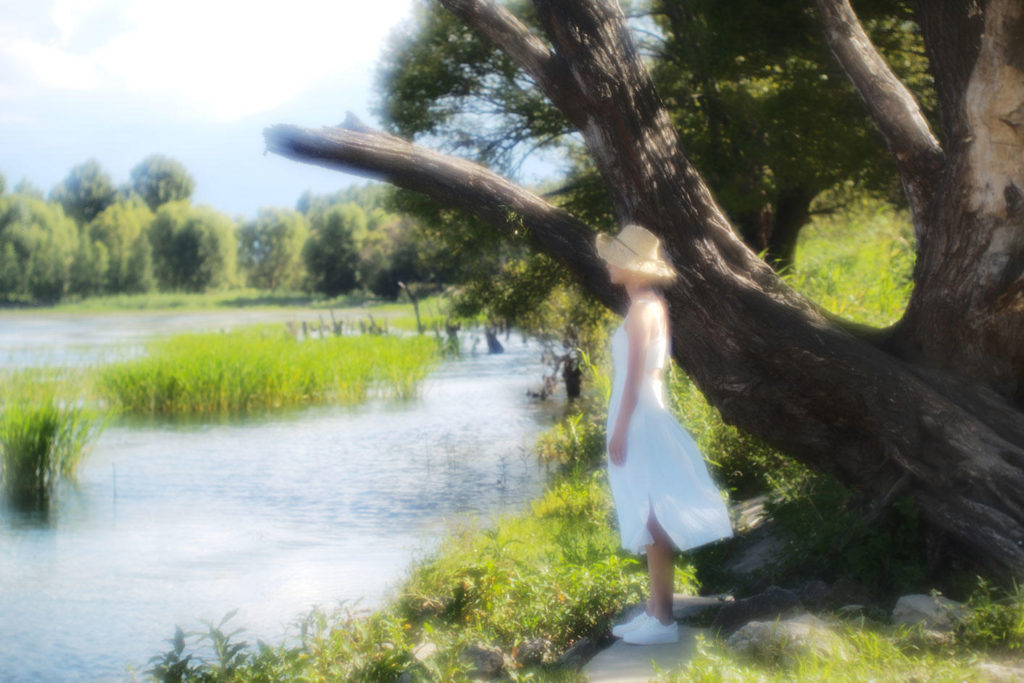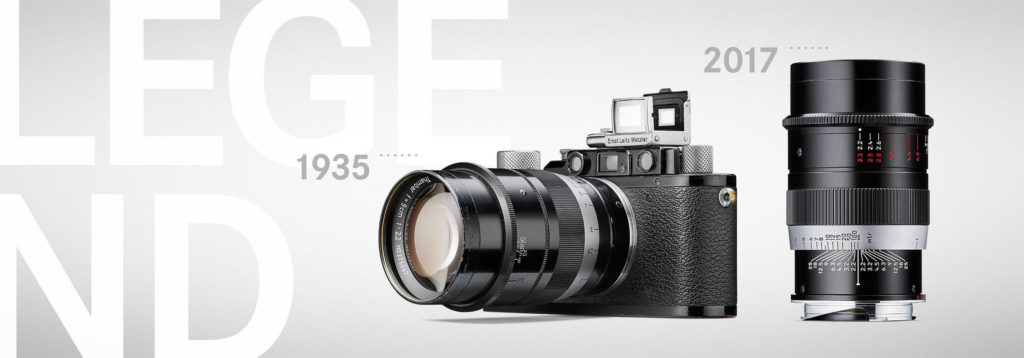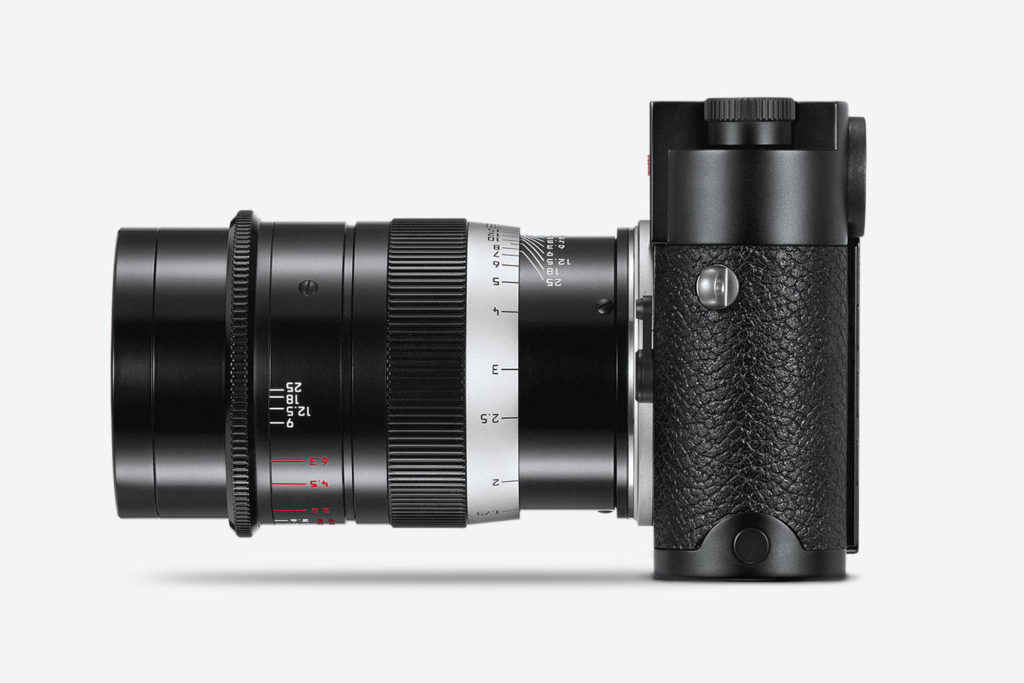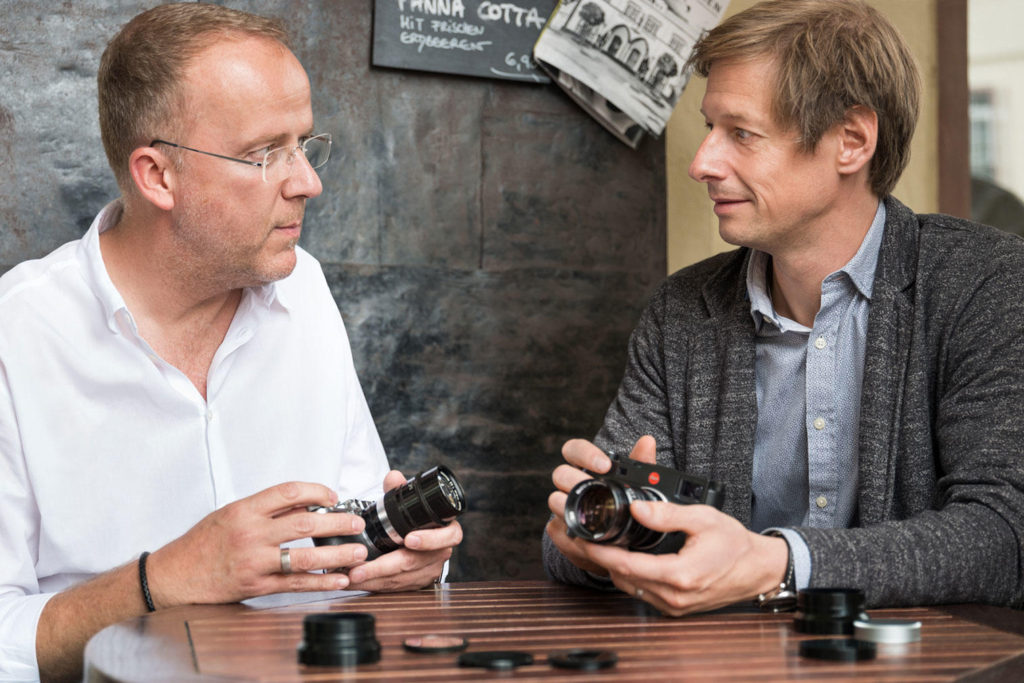Leica has announced an M mount version of the “legendary” Thambar 90mm f2.2 variable soft-focus lens. Leitz offered the original, a modified 4 element Hektor with a cemented middle pair and a bunch of uncorrected peripheral spherical aberration, between 1935-49, presumably for that era’s version of ‘Glamour Shots.’
 Leica’s “Teaser” Photo for the new Thambar
Leica’s “Teaser” Photo for the new Thambar
According to Leica:
The Thambar’s distinctive, dreamily romantic look and unmistakeable bokeh are created by deliberately under-corrected spherical aberrations, along with a 20-bladed aperture for the circular rendition of out-of-focus highlights. Because the aberration increases towards the periphery of the optical system, both the extension of the depth of field and the degree of diffusion can be precisely controlled via the step-less aperture ring. Widening the aperture increases the soft focus, whereas stopping down reduces the effect. The opaque area at the center of the included soft focus spot filter prevents the axial rays, which generate sharp focus, from reaching the sensor – resulting in an even more intense soft focus appearance.
Price is rumored to be $6995.00. If you really want to take dreamy photos of your girlfriend or cat and don’t have that sort of change lying around, you could simply buy a cheap 135mm Hektor (you can pick up a decent one on Ebay for less than $100) attach a generic e39 UV filter to it and smear some Vasoline over the filter. Then again, you might not get the “unmistakeable bokeh” of the Thambar, but, hey, you can’t have everything.




There are also several 90mm Elmars on Ebay for $99 to $150. I bet I could make my own “soft focus spot filter” with a black blob in the center.
The new Thambar, like last year’s 28mm f5.6 Summaron, is a product that involves no exotic glass, no aspheric elements, no manufacturing tolerances beyond what were available in the 1950’s. (I’m sure the metalwork is nice, but so is the metalwork in my kitchen faucet.) They both seem like cynical attempts to generate a product for next to nothing, (by their standards) mark it up by a factor of ten or twenty and laugh all the way to the bank.
It’s this kind of foolishness that has changed Leica’s reputation from the pinnacle of photographic excellence, the camera that Larry Burrows and Henri Huet used, to Veblen goods, the Hermes scarf of cameras. It drives the Leica-hatred that is so evident on the web. It isn’t helped by the ludicrous art-speak on the company’s web pages for these two lenses.
I have film Leicas, I use them every day, I wouldn’t replace them with anything; but the company that made them is dead.
Couldn’t have said it better.
great comment!
+1
An alternative to Vaseline “filtration” effects is the purchase of Hasselblad Softars; they used to come in three strengths, and I bought the Softar 2, I think, which worked nicely on the ‘blad format lenses, but was overkill when used on the Nikkor lenses on the small cameras.
The nice thing about Softars was that you managed to get the best of both worlds: a fairly crisp image with a pretty halo effect on highlights… It looked cool whan you shot with a strong backlight, but kinda pointless otherwise. Such effects can date badly.
Having said which, lovely softness can be see on the Sarah Moon ads for Mateus Rose wines; there’s a shot that I remember of a situation in a boat by the banks of a lake or whatever, with two women and a man doing the wine-pouring thing. So beautiful one could weep for the imaginary world lost!
Didn’t Nikon also make a 135mm lens with variable focus effects available? I think I’d always buy filters before dropping money on a one-trick pony lens.
Excuse the typos in the previous post; here’s a link to the Sarah Moon image, in which one of the women is doing the pouring – I’d remembered it the other way around. Memory sucks! Sometimes.
https://emmapeelpants.wordpress.com/2014/02/27/vintage-adverts-remember-with-mateus-rose/
My memory has it that Mateus Rose was the bee’s knees in wine
My “go to” wine with the young ladies circa 1976. Plus, you could keep the bottle and use it as a candle-holder if you wanted to project a cosmopolitan air.
As I remember, the wine bottle candle holders went next to the avocado pit on three toothpicks in a glass of water.
By the Carole King “Tapestry” album.
I still love that album (Tapestry)
As said above, Leicas 90mm Lenses are dirt cheap. Actually they are the cheapest M-mount lenses and for the most case they are even cheaper than most LTM lenses from Leica, Canon and Nikon.
So why not to get 90/2.8 and just modify it (ruin it) to shoot like this? I bet stripping front element of coating and scratching it a bit would do the trick…
And who uses 90mm on Leica anyway?
Many Tele-Elemarits have a pernicious, permanent internal fog, because Leica picked the wrong lubricant, or glass or something. So they look all dreamy for free.
This is the sort of trick photography that iPhones are becoming increasingly good at, but at a slightly lower capital outlay.
If there isn’t already an app for that sir… there soon will be.
StephenJ
On the MatRos thing: during a shoot in Lisbon we stayed at the Dom Carlos Hotel. I asked the sommelier about MR and he screwed his nose and, to my acute embarrassment, pronounced “factory wine”. This was a trip with three very non-simpatico characters, each tying to hold on to dignity and credibility when, in truth, none of us should have accepted doing the gig together.
A clear case of “Tmar Productions” aka take the money and run.
Photography can sometimes be such fun.
Where has the common sense gone that made Leica great in the first place?
I am thinking of the people at Wetzlar who started it all. Ernst Leitz, Oskar Barnack, Max Berek and Erwin Lihotzky come to mind. Brilliant engineers, not marketing people, were calling the shots at Leitz. These people shared a vision that made it possible to bring the Leica into existence in a time where literally EVERYTHING had to be build in-house and from scratch.
They were all dedicated to the Leitz company and its integrity in a way that seems impossible today – where something over here is always intertwined with something else at the other end of the world in this damned craziness called global economy.
We live in this tunnel where someone is always asking someone else “where do you see yourself in five years time?”
Had that same question been put, let’s say, to Max Berek back then, you probably would’ve gotten this answer: I will be right here at Leitz, in Wetzlar – until I die.
I agree. These lenses are just an atrociously bad and cynical idea. To add another illustrious name to those cited above, could anyone imagine Walter Mandler, a man who could ray-trace armed only with a cigar, pencil and paper, leaning back in his chair and saying “Let’s just put out this lens with uncorrected spherical aberration, that’s fine” …
I sometimes think that Leica should have poured its resources into making its own reflex camera and developing it to the maximum instead of farming out.
The only reason I didn’t go for the R6 at the time was that it lagged my old Nikons in ability and the crucial aspect of 100% frame coverage on the screen. On a small camera format, that’s pretty well essential for any working pro: you have to make the very most of the tiny space you have.
Yes, a lot more expensive than the competition, but so was the Hasselblad 500 series and nobody who could afford it thought twice about going there! And doubling up.
I never checked how accurate the ‘blad screens were, but 120 film offered a lot of scope for little crops. After all, most shots didn’t reproduce as squares.
Rob
Everything rises and falls on leadership. Its irrelevant whether the Thambar sells well or not – the leadership (and user) culture that allowed that to emerge from Leica needs to be purged.
Time for a buyout – along with a significant leadership change.
Not unique to Germany: Nikon seems to be have made some odd decisions since the Df which didn’t really address the problems some find that dslr bodies give that slr bodiues did not. There are so many old, good Nikkors in the world that not being able to manually focus them well on a dslr-type screen seems silly.
I’d take a real split-image focussing aid any day to having to go mad trying to see a little green light go on or not go on at the far edge of vision!
Rob
Indeed, a lot of those manual-focus Nikkors are fantastic; optically as well as mechanically. And very affordable these days. I use them regularly. The 35/2.0, 50/1.2, and the 105/2.5 are all top-notch. The 25-50/4.0 zoom was a sensation at the time of introduction – still is – and built like a tank. The 50/1.8 “pancake” is a sleeper. Outstanding in available light, even wide open.
I still own a Nikon EL2, also a sleeper – and a keeper.
Tadeas makes a valid point about a front element. I got a generic 39mm filter, punched a paper disc out with an office punch and mounted it on the centre of the filter and coloured it black. On my 90mm f2.8 Elmarit, it shows promise. However, nothing beats my screw-mount Summar. I applied a spot of Brasso to the front element and kept up the treatment until I got just the look I wanted. Mind you, much can depend on light conditions. Sunlight really improves things.
I’ll pass up on the new Thambar.